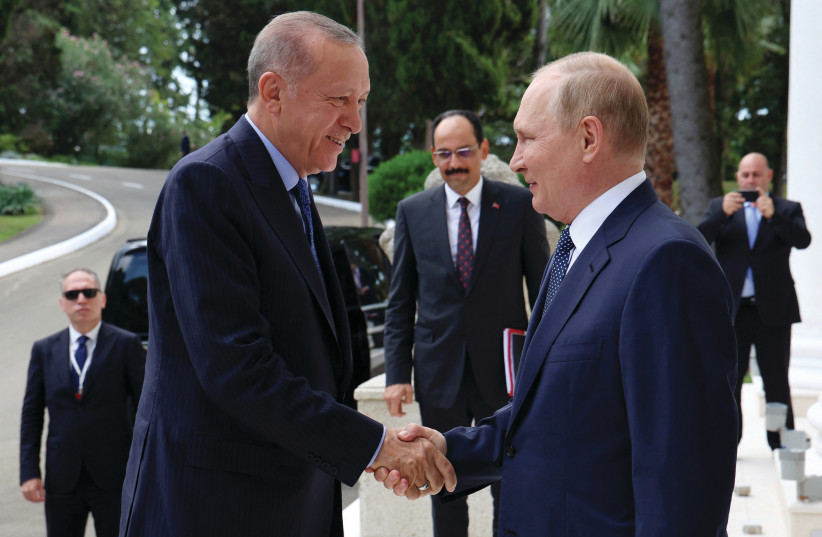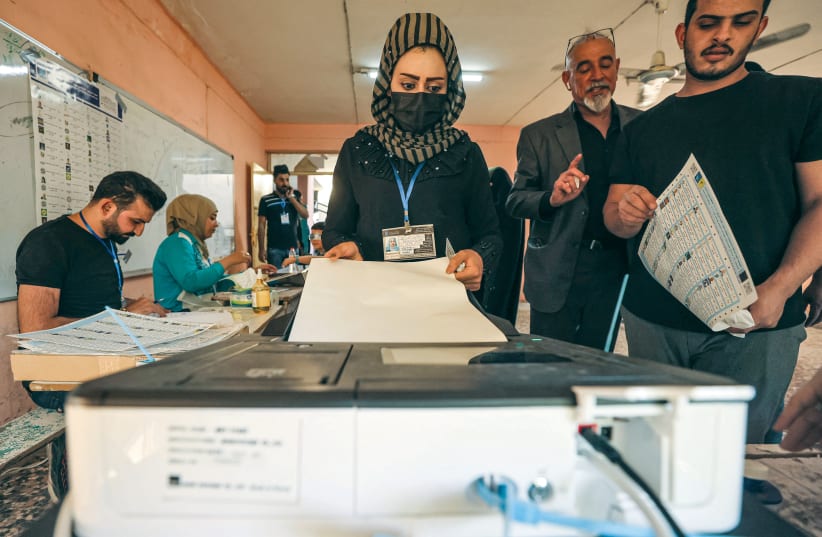The past year in the Middle East has brought little change from the overall trends that were clear the year before.
This is not to say that nothing has changed. There are continued advances in ties between Israel and the Abraham Accords countries, and a new initiative is aimed at linking Israel, the UAE, the US and India. The overall trend in the region is toward the solidification of various regional powers – Turkey, Iran, Israel and Saudi Arabia – and the reduction of influence of terrorist extremists.
Turkey-Russia-Iran alliance
One major trend in the past year has been the continued integration of Turkey into an alliance and partnership with Russia and Iran.
Turkey was already working with Russia and Iran as part of the Astana process for Syria. The goal of this process was to let Iran, Russia and Turkey decide the future of Syria.
These countries agree on several issues: They want the US presence in Syria reduced, and they generally want to sideline independent Syrian groups.


Toward that end, Iran has taken over an area in southern Syria, via proxies, in order to threaten Israel. Turkey has taken over parts of northern Syria. The US helps the Syrian Democratic Forces – a grouping of Kurds and Arabs – secure eastern Syria.
Last September, Russia and Turkey were meeting in Sochi in southern Russia to determine the future of Syria. Turkey’s President Recep Tayyip Erdogan said that peace in Syria depends on relations between Ankara and Moscow. He was speaking in Sochi alongside Vladimir Putin, according to reports. “President Erdogan underlined the importance of his country’s joint actions with Moscow in the context of the Syrian conflict,” said Turkish government TRT media.
Iraqi elections and a pro-Iran group setback
On October 10, 2021, Iraq had elections. The elections were a setback for the pro-Iranian groups in Iraq. These groups, called Hashd al-Shaabi, also have political arms in parliament. There are other pro-Iranian leaders in Iraq, such as Nouri al-Maliki.
However, the outcome of the elections didn’t secure a coalition that could supplant Iran’s role. Iran has been suppressing Iraqis via its proxies for years, and in 2019 many protesters responded, sacking pro-Iranian political party offices. But the result was not change in Iraq. Instead, a prime minister called Mustafa al-Kadhimi came to power. But he could not stop the trend of Iran taking over parts of Iraq and using Iraq as a platform to attack the US and Israel. A drone was launched from Iraq against Israel in May 2021. Iraqi militias, backed by Iran, also used drones in August to target US forces in Syria. In response, the US launched airstrikes.
A weakening Kurdistan autonomous region in Iraq
Overall, the trend in Iraq has weakened the Kurdistan autonomous region. Turkey has carried out airstrikes in northern Iraq, claiming to target PKK “terrorists.” One of these strikes killed a number of Iraqi tourists who had gone to the Kurdish region for peace and quiet. Iraq was angry but could do nothing to get the Turks to stop.
The Kurdish political parties, KDP and PUK, are also divided. The PUK is close to Iran, and between them the groups couldn’t help form a coalition government led by Muqtada al-Sadr, a cleric. So Sadr decided to leave politics in the summer of 2022, creating a new crisis. His followers sacked the Green Zone, angry over the political impasse. This has left a vacuum of power, into which Iran has continued to step.
The Kurdistan Region is now isolated. Its only sliver of hope is in reform of its armed forces, the Peshmerga. There have been increasing attempts over the past year to reform these forces and continue to secure Western backing. The US needs the Kurdish Region because it is one of the few areas in Iraq where they can have facilities for troops that are secure.
Things stay the same in Syria
Meanwhile, across the border in Syria, not much has changed. The US backs the SDF, and the SDF secures ISIS detainees in al-Hol and other camps. But as the detainees continue to linger, there are questions about whether some will escape and whether ISIS could make a comeback.
In the Euphrates River Valley, Iranian agents have plotted attacks on US forces in Shadadi and Omar oil field. Drones and rockets have been used to harass US forces. In addition, Iran has targeted the Tanf garrison, another US base, in Syria. Dozens of attacks have taken place since last October, but most of them went underreported, and there was little response from the US. The US didn’t want harsh responses because it prefers to keep the peace.
Turkey makes moves with Syria, Ukraine, Russia, Armenia, Greece
Across the border in Turkey, the Ankara regime is continuing to threaten an invasion of Syria. Turkey has already invaded parts of Syria, beginning in 2016. It often uses Syrian rebels as proxies to fight Kurds. In this recent case, Turkey has been testing the waters of NATO and the US to see if a new invasion can be brokered.
The Russian invasion of Ukraine in February gave Turkey more leverage. Turkey has sold drones to Ukraine and uses drones to attack people in Syria. Turkey wants to sell drones all over the Middle East and hopes that recent use of drones will be a selling point. Turkey has also brokered a grain deal with Ukraine and Russia and exploits European energy concerns to secure more deals. It also prodded Azerbaijan to clash with Armenia.
Turkey threatened Greece in the spring and summer, causing a new crisis with NATO-member Greece.
For Israel, the changes this past year were complex
FOR ISRAEL, this is a complex set of changes.
Iran has tried to target Israel with drones, including flying the drones from Iraq and Iran. Israel and US Central Command relations are growing, and as such US-led coalition aircraft reportedly downed Iranian drones earlier this year. In addition, Iran has sent drones to Russia, expanding its drone role.
Israel has continued operations in Syria in the “war between the wars” campaign to stop Iranian entrenchment. The Syrian regime blamed Israel for two rounds of airstrikes on Aleppo and Damascus airports in August and September 2022.
In 2022 there has also been a lot of talk about the Iran deal. Iran has continued to enrich uranium and is reported to be just weeks away from having enough material to build a bomb. However, Iran has been at this red line for years, and it is not clear when Iran might “break out.”
The US had worked with Russia on the Iran deal before the Russian invasion. Now Russia is more closely allied to Iran and wants to use the deal to get around sanctions. Iran joined the Shanghai Cooperation Organization in September, and Iran’s leader went to Uzbekistan alongside Turkey, China, Russia and other authoritarian regimes to attend the SCO meeting. This was a major confab designed to showcase that these countries can balance the US-led world order.
Meanwhile, Israel and the UAE celebrated the second anniversary of the Abraham Accords. Bahrain, Morocco and other countries are now peace partners of Israel, and all these ties are growing. Israel has hosted the Negev Forum of countries, which includes Bahrain, Egypt, Israel, Morocco and the UAE; and with US support for this important group, it is clear that the Abraham Accords and subsequent partnerships are reaching new heights. This is also clear in Israel-India ties and the I2U2 partnership of India, Israel, US and UAE. The first I2U2 summit took place in July.
Israeli leaders have continued outreach to Morocco and the Gulf. Israel has also rekindled ties with Turkey. This shows that a new regional order could be taking shape. But will Israel really risk closer ties with Turkey if Turkey doesn’t break ties with Hamas? Iran has continued to try to target Israelis in places like Turkey, raising alarms.
At the same time, Israel has launched the Octopus Doctrine to target Iran directly. Israel is also building lasers to stop Iranian missiles supplied to terrorist groups.
Time will tell whether the same trends will prevail or whether there will be shake-ups – minor or major – that make waves. ■
